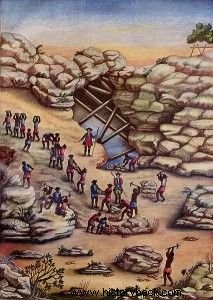Thegold cycle it is the time when the extraction and export of gold figured as the main economic activity in the colonial period.
It began at the end of the 17th century, when sugar exports from the Northeast were falling due to the competition exerted by the English and Dutch sugar production in the Caribbean.
Summary on the Gold Cycle
The extraction of gold caused changes in the occupation of the territory.
There was a large flow of people who came from Portugal and the northeast coast to the mining region. There was also an increase in the enslavement of indigenous people and Africans.
In order to ensure control over the extraction and shipment of the metal, the Crown imposed various taxes and transferred the capital of Brazil from Salvador to Rio de Janeiro.
Finally, between 1750 and 1770, Portugal was experiencing economic difficulties resulting from mismanagement and natural disasters. In addition, it was under pressure from England, which, as it industrialized, sought to consolidate its consumer market, as well as its world hegemony.
Thus, the discovery of large quantities of gold in Brazil, became a reason for hopes of enrichment and economic stability for the Portuguese.
See also:The Chemical Element Gold (Au)
Gold cycle in Minas Gerais
The gold deposits discovered in Minas Gerais, Goiás and Mato Grosso were divided into mines (auriferous lots for exploration).
During the height of this cycle, in the 18th century, thousands of people flocked to these regions and the population is estimated to have doubled in a century.
Enrichment gave rise to a literate elite. Several children of gold explorers could be sent to the University of Coimbra where they would come into contact with Enlightenment ideas.
The economy is also more dynamic, as agricultural trade takes place around the mines to feed those who work there and the emergence of small manufactures. However, these would be banned in 1785.
The gold exploration became the most profitable in the colony. For this reason, the colonial capital of Salvador was transferred to Rio de Janeiro, in order to ensure inspection in the mining regions.
Officially, 35 tons of metal were extracted, but it is believed that it must have been much more, as a part was withheld.
Finally, the gold cycle lasted until the end of the 18th century, when the mines were exhausted, in the midst of the Industrial Revolution in England.
Exploration and management of gold
This period represented the greatest moment of control of Brazil by Portugal, as the Crown charged high taxes on the ore extracted.
These were cast and taxed in the Casas de Fundição , where they received a stamp attesting that the tax had already been paid. However, there were deviations and, when discovered, they were heavily penalized.

The main control mechanisms were:
- Fifth: 20% of all gold production would go to the King of Portugal;
- Spills: a quota of approximately 1,500 kg of gold per year that should be reached by the colony, otherwise, the assets of the lords of the mines were pawned;
- Capitation: tax paid by the landlord for each enslaved person who worked on his plots.
We realized that the high taxes, fees, punishments and abuses of political power exercised by the Portuguese over the people who lived in the region generated conflicts that would culminate in several revolts.
At the same time that this economy brought population growth, it also generated poverty and inequality, as the profits from mining operations were not reinvested in productive activities.
After this period, Brazil would remain as a simple exporter of primary products, stagnant in this vicious cycle and without achieving the technical scope capable of promoting its economic development.
Min Confidence
The rush for gold, the charges and abuses of Portuguese political power caused shocks such as the War of the Emboabas (1707 to 1709).
Among these conflicts, however, the most notable was the Inconfidência Mineira, also known as Conjuração Mineira.
Consequences of the Gold Cycle
The Gold Cycle had repercussions in Brazil, Portugal and England. In the words of the writer Eduardo Galeano:
For Brazil, it represented the shift of the economic axis from the northeastern coast to the interior and the change of the capital from Salvador to Rio de Janeiro.
With the enrichment of the elite, more young people were able to study in Europe, at a time when the Enlightenment was spreading across the continent. Upon returning, books about this movement were brought and read by several people.
For the enslaved, gold brought the hope of freedom and the emergence of a layer of freedmen.
In Portugal, gold made possible constructions such as the Palácio de Mafra, a complex that includes a church, house, convent, vegetable gardens and land for hunting.
In England, linked to Portugal by the Treaty of Methuen, gold guaranteed the payment of English manufactured products.
Also know about other economic cycles in Brazil :
- Brazilian Business Cycles
- Sugar Cane Cycle
- Coffee Cycle
- Rubber Cycle
- History Questions in Enem
- Exercises Colonial Brazil
- Engenho in colonial Brazil
Bibliographic References
Mine gold. Graphics:Gold production and mining population in the 18th century. Atlas FGV. Consulted on 11.20.2020.
